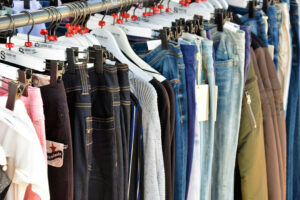ACCORDING to Rey Eliseo Torrejos, Associate Scientist at the Department of Science and Technology – Philippine Textile Research Institute (DOST-PTRI), there’s way too much clothing in the world.
During the National Textile Convention on Jan. 31, Mr. Torrejos, in a talk called “Philippine Textile Recycling Frameworks,” brought out a graph showing the increase of gross domestic product (GDP), the rise in population, and increasing sales in clothing. A fainter line shows a drop in clothing utilization rate. “What this implies is that there’s actually enough clothing on the planet to clothe the next six generations of the human race,” he said.
In the Philippines, 267,111 tons of textile waste are dumped in landfills each year, according to data gathered from the Solid Waste Management status report.
Mr. Torrejos said that the clothing industry is one of the world’s most polluting, with the industry contributing to 10% of global greenhouse gas emissions. Meanwhile, there are five million tons of microfibers found in the oceans every year, shed from washing and other clothing-related practices. “That’s why the DOST-PTRI (Department of Science and Technology – Philippine Textile Research Institute) promotes the utilization of natural fibers. Unfortunately, if we want to clothe all the people in the world, natural fibers are not enough. We really need to consider utilizing synthetic fibers as well,” he said. According to him, almost 80 million tons of synthetic fiber are produced every year (though he estimates it could go up to 100), while only 30% of the world’s production is natural or plant-based.
The rest of the world is gearing up on its recycling efforts: 15% of the textile waste in the US is currently being recycled. Around 39% of the textile waste generated in the world is from poly-cotton blends, which are harder to recycle, because in some cases, the natural and synthetic fibers must be separated chemically in a series of expensive procedures.
Philippine startups Wear Forward and Humble Sustainability collect clothes for recycling and upcycling, Mr. Torrejos pointed out, but the process gets more difficult when synthetics get in the way, because of the mentioned difficulty in chemically separating the fibers.
However, he said there is another approach. “You don’t need to separate the fibers, but you (use) a binder to bond the products together and then form new products.”
The DOST-PTRI is working on a few solutions: these include developing a Near-Infrared device with Mapua University to identify clothing by fiber to ease the segregation efforts, as well as binding together textile waste with fungi (a partnership with Central Luzon State University) to make things like alternative leather and new products.
In a partnership with Chonnam National University in South Korea, they’re studying a bioengineered cellulase to degrade cellulose fibers. “We really can’t do this without the help of other researchers,” he said. “Our goal is also to diversify.” — JLG
